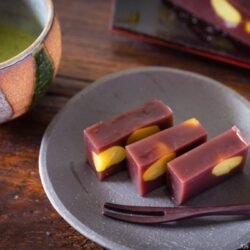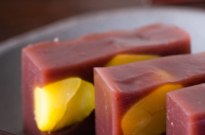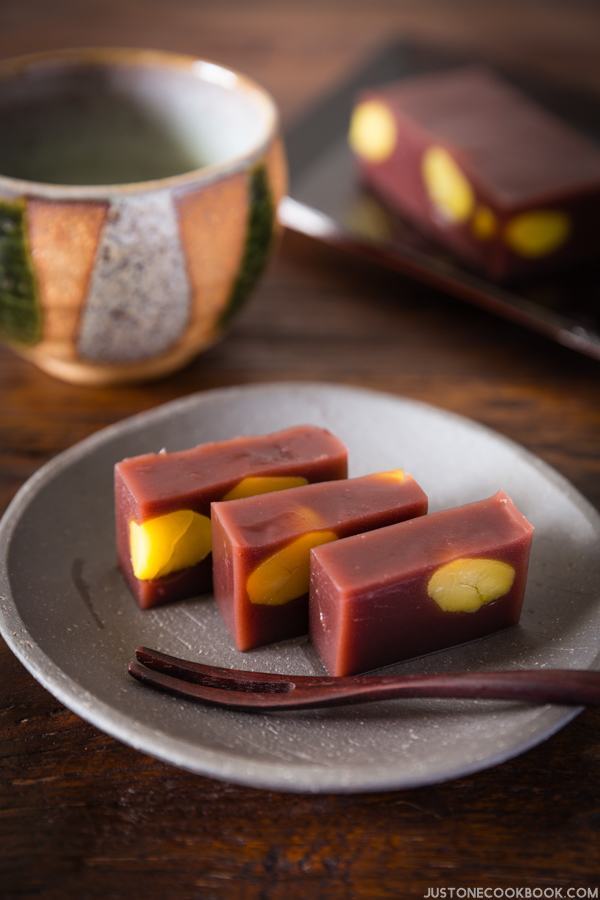
Have you tried or seen a Japanese red bean jelly called Yokan (羊羹, ようかん)? This traditional Japanese sweet is usually shaped like a rectangular block and the texture is pretty firm so even when sliced thinly it would stand upright.
Compared to colorful western-style jellies, Yokan might seem a bit dated and rather boring. However, it is absolutely one of the best treats when enjoyed with matcha; the sweet taste of azuki and bitter taste of matcha complements each other perfectly.
So.. what is Yokan and Mizu Yokan?
Yokan is made of just a few simple ingredients; azuki red bean paste, sugar, and kanten (If you never heard of this ingredient, visit this page). Unlike gelatin, kanten is vegan/vegetarian friendly, so everyone can enjoy this jelly.
There are two types of Yokan. The firmer jelly is Neri Yokan (練ようかん) or simply, Yokan. It includes a higher concentration of kanten so it’s firmer, and the texture is also thick and heavy.
Mizu Yokan
When the proportion of water content is higher, the jelly is called Mizu Yokan (水ようかん), as mizu means “water” in Japanese. Because it doesn’t taste as heavy as Neri Yokan, chilled Mizu Yokan is often enjoyed during the summer.
My family prefers Mizu Yokan over regular Yokan and today I’m sharing a very easy Mizu Yokan recipe, and I think it’s more enjoyable if you’re new to these traditional Japanese sweets.
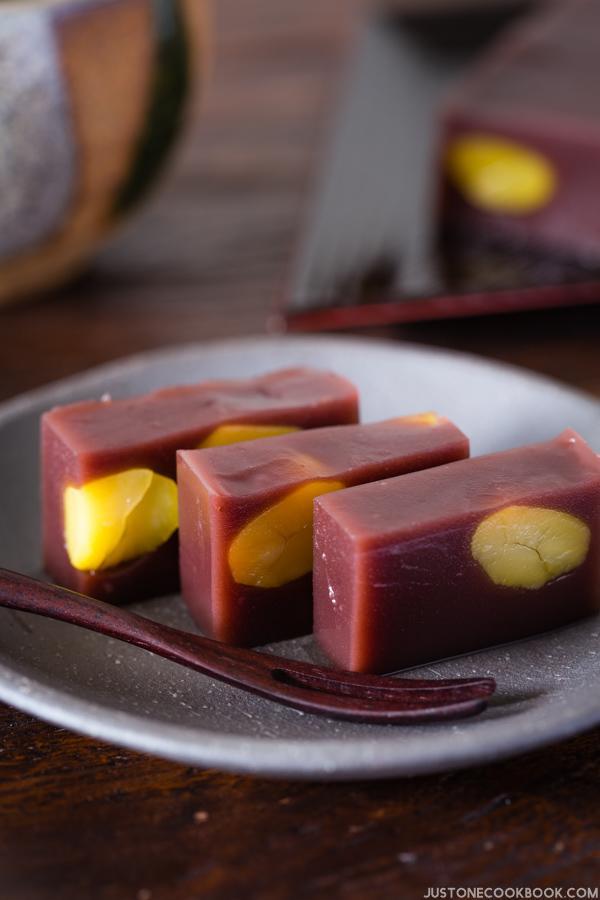
Various Types of Yokan
Instead of Azuki red beans flavor, some yokan is instead made with chestnuts (Kuri Yokan 栗ようかん), Japanese sweet potatoes (Imo Yokan 芋ようかん), or the combination of white beans and Matcha (Matcha Yokan 抹茶ようかん).
The regular red bean flavored yokan may also include chestnuts (like how I made them today) and call it Kuri Yokan. I think it’s much prettier to have golden chestnuts inside the jelly and they taste wonderful with red bean flavor.
How Do I Find Chestnuts When They Are Not In Season?
Don’t worry, you can get chestnuts all year round. And even better, you don’t have to cook and peel the chestnuts. When you go to a Japanese grocery store, look for Kuri no Kanroni (栗の甘露煮) (see the picture here), which is a jar of chestnuts preserved in syrup.
French cuisine also uses marron glacé (candied chestnuts) in desserts and I think you can use French chestnuts as well.
Where to Find Nagashikan?
Nagashikan (流し缶) is the removable tray that we use to make Yokan. You can find it on Amazon and Rakuten. For more details about this special mold, please read my Fruit Jelly recipe post.
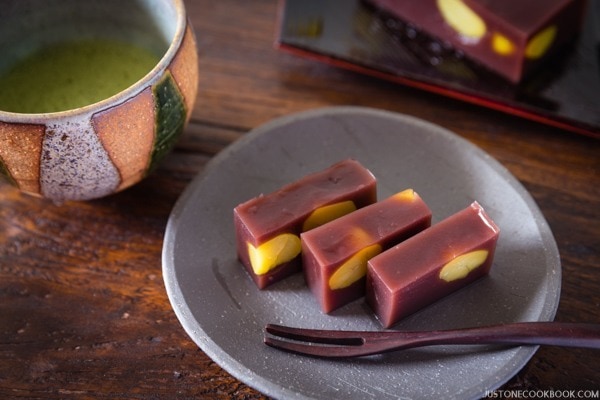
Wish to learn more about Japanese cooking? Sign up for our free newsletter to receive cooking tips & recipe updates! And stay in touch with me on Facebook, Pinterest, YouTube, and Instagram.
Mizu Yokan
Ingredients
- 14 oz sweet red bean paste (anko) (use koshian or fine red bean paste; the sweetness of anko varies, depending on the brand; adjust with additional sugar, to your taste; see how to make homemade Anko)
- 1½ cups water
- 4 g kanten (agar) powder (1 stick packet; see Notes)
- ⅛ tsp Diamond Crystal kosher salt
- 1 jar kuri kanroni (chestnuts in heavy syrup) (7 oz, 200 g)
Instructions
- Before You Start…Please note that this recipe requires 2 hours of chilling time.Gather all the ingredients. I use a nagashikan (6 x 5 x 2 inches or 15 x 13.5 x 4.5 cm). If you do not use a nagashikan, you might want to use plastic wrap to line your mold for easy removal later on.
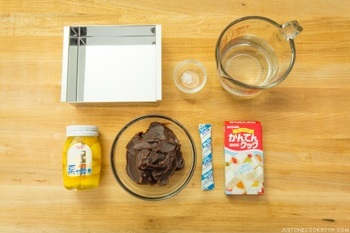
- To a small saucepan, add 1½ cups water. Then, add 4 g kanten (agar) powder. Whisk well and bring to a boil.

- Once boiling, lower the heat. Whisk and let the powdered kanten dissolve completely, about 2 minutes.

- Add 14 oz sweet red bean paste (anko) and dissolve the koshian paste with a silicone spatula.

- Once the red bean paste has completely dissolved, add ⅛ tsp Diamond Crystal kosher salt. Remove from the heat to let it cool a bit, about 2–3 minutes.
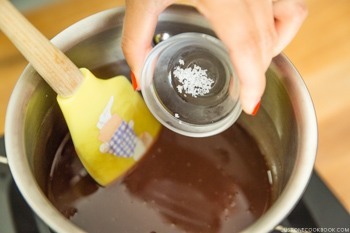
- Pour some of the red bean mixture into the mold until the bottom of the nagashikan is covered, about ¼ inch (0.6 cm) deep. Then, let it cool at room temperature until it has set, about 10 minutes (the time varies depending on the temperature of your kitchen).

- Once solidified, place the chestnuts from 1 jar kuri kanroni (chestnuts in heavy syrup) on top, spacing them evenly apart from each other.
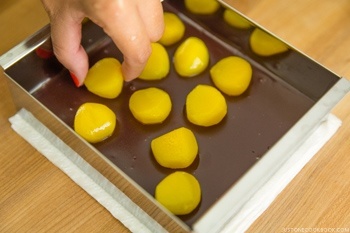
- Pour the rest of red bean mixture over so that it covers the chestnuts. Let it cool on the counter for about 15 minutes to set. Then, wrap and transfer to the refrigerator until it has completely chilled, about 2 hours.

To Serve
- Remove from the refrigerator. Run a knife along the edges of the nagashikan and lift the inner removable tray. Slide the yokan out of the inner tray onto a cutting board.

- Cut the yokan into 3 rectangular bars, then slice each bar into pieces ½–1 inch (1.3–2.5 cm) thick. Serve chilled.
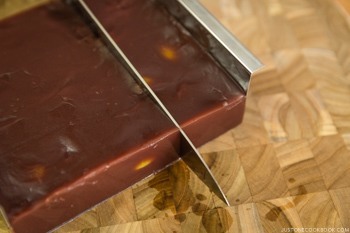
To Store
- You can wrap and store the Mizu Yokan in an airtight container and keep it in the refrigerator for 3 days.
Notes
- kanten powder: ½ stick packet (2 g)
- kanten bar: ½ bar (4 g)
- kanten threads: 12 threads (4 g)
Nutrition
Did you make this recipe?
Tag @justonecookbook on Instagram so we can see your delicious creation!


